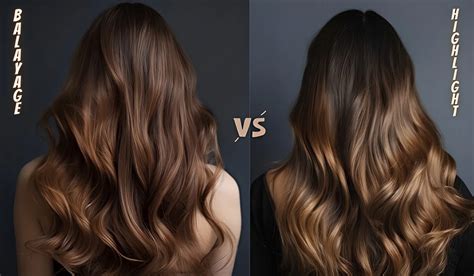Balayage & Highlights 101: A Comprehensive Guide to the Latest Hair Trends

Section 1: Understanding Balayage & Highlights
Balayage (French for “to sweep”) is a freehand hair painting technique that creates soft, natural-looking highlights. Unlike traditional highlights, which use foils to isolate strands, balayage blends colors seamlessly for a more sun-kissed effect.
Highlights are sections of hair lightened to frame the face and add depth and dimension to the hair. They are typically applied using foils or a cap to isolate the strands from the rest of the hair.
| Feature | Balayage | Highlights |
|---|---|---|
| Technique | Freehand painting | Foils or cap |
| Effect | Soft, subtle | More defined, contrasting |
| Longevity | Lasts longer (6-9 months) | Fades faster (3-6 months) |
| Maintenance | Less frequent touch-ups | More frequent touch-ups |
| Cost | Generally more expensive | Generally less expensive |
Section 2: Benefits of Balayage and Highlights
- Creates a natural, sun-kissed look
- Enhances hair’s texture and depth
- Less damaging than traditional highlights
- Allows for a wide range of shades and placements
- Suitable for all hair types and colors
- Brightens the face and adds contrast
- Creates a polished, chic look
- Versatile, can be customized to suit any style
- Can help cover gray hair
- Can add dimension to fine or thin hair
Section 3: Choosing the Right Technique for You
The best technique for you depends on your desired look, hair type, and lifestyle.
- Balayage: Ideal for those seeking a low-maintenance, natural look.
- Highlights: Suitable for those wanting more defined, contrasting highlights or to cover gray hair.
Section 4: The Balayage and Highlight Process
- Hair is sectioned and pre-lightened at the roots.
- A colorist paints on lightener freehand, creating a soft gradient effect.
- Hair is processed for the appropriate amount of time.
- Hair is toned to add depth and remove any brassiness.
- Hair is sectioned and foils or a cap are applied.
- Lightener is applied to the isolated strands.
- Hair is processed and foils or cap are removed.
- Hair is toned to neutralize any unwanted tones.
Section 5: Maintenance and Styling Tips
Maintenance:
- Touch-ups are typically needed every 6-9 months for balayage and 3-6 months for highlights.
- Use sulfate-free shampoos and conditioners to protect color.
- Deep condition regularly to keep hair healthy and prevent breakage.
Styling:
- Use a heat protectant spray before blow-drying or using heat styling tools.
- Add texture to hair with dry shampoo or sea salt spray.
- Incorporate braids or waves to create playful and stylish looks.
Section 6: Frequently Asked Questions (FAQs)
-
What is the difference between balayage and ombré?
– Balayage creates a soft gradient effect from roots to ends, while ombré is more defined and features a stark contrast between colors. -
Can I do balayage or highlights at home?
– It is not recommended to attempt balayage or highlights at home as it requires professional expertise and training to achieve the desired results. -
How long does balayage or highlights take?
– The time varies depending on the length and thickness of hair, but generally takes 3-6 hours. -
Can I color my hair after balayage or highlights?
– Yes, but it is important to wait at least 2 weeks after the initial treatment to allow the hair to rest. -
Do balayage or highlights damage hair?
– All chemical treatments can cause some damage, but balayage is less damaging than traditional highlights due to its freehand application technique. -
How much do balayage or highlights cost?
– The cost varies depending on the salon, colorist, and length of hair, but typically ranges from $100-$500.
Section 7: The Future of Balayage & Highlights
The popularity of balayage and highlights is expected to continue growing in the coming years. As technology advances, new techniques and products will emerge to enhance the versatility and longevity of these treatments.
Inspired Innovation: “Chromatique Contouring”
Chromatique contouring is a cutting-edge concept that combines balayage and highlights to create a custom-tailored color that enhances facial features and complements skin tone, drawing inspiration from the principles of contouring makeup.
Tables
| Table 1: Comparison of Balayage and Highlights | Table 2: Benefits of Balayage and Highlights |
|---|---|
| Technique | Balayage: Freehand painting |
| Effect | Soft, subtle |
| Longevity | 6-9 months |
| Maintenance | Less frequent touch-ups |
| Cost | More expensive |
| Benefits | Balayage |
| — | — |
| Natural, sun-kissed look | Yes |
| Enhances hair’s texture and depth | Yes |
| Less damaging than traditional highlights | Yes |
| Allows for a wide range of shades and placements | Yes |
| Suitable for all hair types and colors | Yes |
Tips and Tricks
- Ask your colorist for a “root melt” to create a seamless blend between your natural color and highlights.
- Experiment with different toning options to customize the shade and enhance the overall effect.
- Use a gloss treatment to add shine and protect color from fading.
- Deep condition regularly to keep hair healthy and prevent breakage.
Step-by-Step Approach to Balayage or Highlights
- Consultation: Discuss your desired look with a professional colorist.
- Pre-lightening: Lighten the hair at the roots to create a base for the highlights.
- Application: Apply lightener freehand (balayage) or using foils/cap (highlights).
- Processing: Leave the lightener on for the appropriate amount of time.
- Toning: Neutralize any unwanted tones and add depth to the hair.
- Styling: Create your desired look using styling products and techniques.
